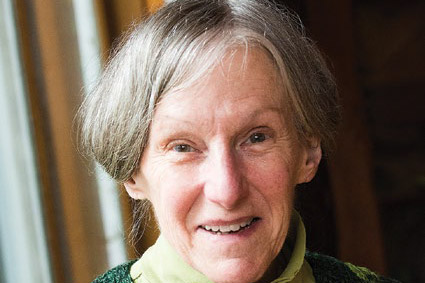Project to make Cornell Greater > Than ever
A brand new science facility, the first free-standing academic building built since the adoption of One Course At A Time, the largest cash gift in college history, a new campus entrance from the east. 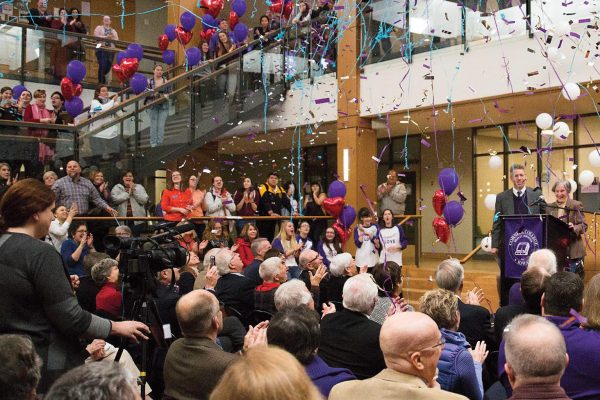
This exciting news, a Cornell Big Bang of sorts, came on Valentine’s Day at an event with students, faculty, staff, alumni, and friends waiting in suspense (and many alumni watching live). As President Jonathan Brand announced the $35 million Science Facilities Project, with a lead gift of $20 million from Jean Russell ’65, cheers rang through the Thomas Commons, while streamers, confetti, and balloons filled the air over the Orange Carpet.
“We’ve dreamt of this day for our college and our students for years,” said Cornell College President Jonathan Brand. “The Science Facilities Project will ensure that our facilities match the quality of the education that occurs inside them. It will transform the student experience. Further, this is one of the most profound ways that we can say to our alumni and friends—Cornell College is going places.”
Thanks to the impressive support of many Trustees, alumni, and friends of Cornell, the project includes a new four-story science building next to West Science, as well as renovations to West Science and two floors of Law Hall. Groundwork has already started, and construction begins this spring. The Russell Science Center is projected to open in January of 2019, and crews are planning to finish renovations in West Science and Law Hall by the fall of 2019. Once the projects are complete, the college’s STEM (science, technology, engineering, and math) space will more than double to 103,600 square feet.
The expansion and renovation for the sciences have been, far and away, Cornell’s highest capital priority and the immediate and primary focus of a new campaign, Greater > Than, The Campaign for Cornell College. In two years the college has received $32 million in gifts, leaving $3 million to be raised for the science project. The multi-year campaign is currently directed toward the Science Facilities Project, and will eventually focus on gifts to grow the endowment. Achieving these goals will continue Cornell’s momentum toward making the Cornell experience Greater>Than ever before and securing Cornell’s future as an exceptional national liberal arts college.
The case for science facilities
“Take one step into West Science, and it is clear that the build-ing does not match what happens in the classrooms and labs,” wrote President Brand in a recent white paper. “An aging and cramped facility outdated for science instruction, West Science severely limits our ability to recruit and retain high-caliber students, provide current students and faculty with a high-quality setting for teaching and learning, and accommodate enrollment growth in our science programs.”
Built in 1976, prior to One Course At A Time, West Science does not allow for the possibilities presented by a synthesis of One Course with the major shift in science pedagogy in the last 25 years. Spaces aren’t large enough nor flexible enough for labs to integrate into the learning process. And the facility is outdated—for example, the fume hoods in the chemistry labs use plumbing from the 1970s that isn’t energy efficient.
“Cornell’s small class sizes and One Course At A Time curriculum dissolved the conceptual wall between the laboratory and classroom long before such integration became a national trend,” Brand said. “Students learn science by ‘doing’ science. And, the results show in our students: Cornell’s science students take full advantage of the high impact educational practices available to them, excelling as a group during their undergraduate studies and enrolling at a high rate in postgraduate programs.”

As one powerful example, Brand noted, Cornell’s 2008–2015 medical school acceptance rate is 75.4 percent, compared to the national average of 40.5 percent for the same years.
“Indeed, the fact that Cornell’s science programs inspire such remarkable outcomes for our students is a testimony to the dedication of our faculty and staff,” Brand said.
A transformative gift
Jean Russell’s astonishing gift for this project is the largest cash gift in Cornell’s 164-year history. Her philanthropy honors her Cornell experience as well as her father’s legacy. She studied biology and chemistry on the Hilltop, earned a Ph.D., and made important discoveries about bone disease as a researcher (see full story).
“My ability to undertake scientific investigation was truly deepened at Cornell,” she said. “It provided the essential groundwork to thrive in the scientific field and well beyond it too. After all, these investigative skills carry through the rest of one’s life. This is why we must ensure that future Cornell students have the best scientific opportunities and spaces possible.”
She was beginning to consider a gift when she was touring West Science during a trip to campus and came upon her former chemistry professor, Addison Ault. Ault, who taught at Cornell from 1962 to 2016 and had Russell in his first organic chemistry class, told her that Cornell’s facilities no longer compare to those of our peer colleges. Furthermore, he said that while he hoped that the college could continue to attract extraordinary students in the sciences, he questioned how long that would be possible without a major investment in Cornell’s science facilities.
Many other Trustees, alumni, and friends have stepped up to make sure Cornell students and faculty will have the modern facilities they deserve. Joining Russell as lead donors are Richard Small ’50 and honorary alumna and trustee Norma Thomas Small, the Hall-Perrine Foundation, and Jerry Ringer ’59 and honorary alumna Carole Ringer. Chairing the Greater > Than campaign is Trustee and Board Chair-elect Gilda Vinzulis Boyer ’84.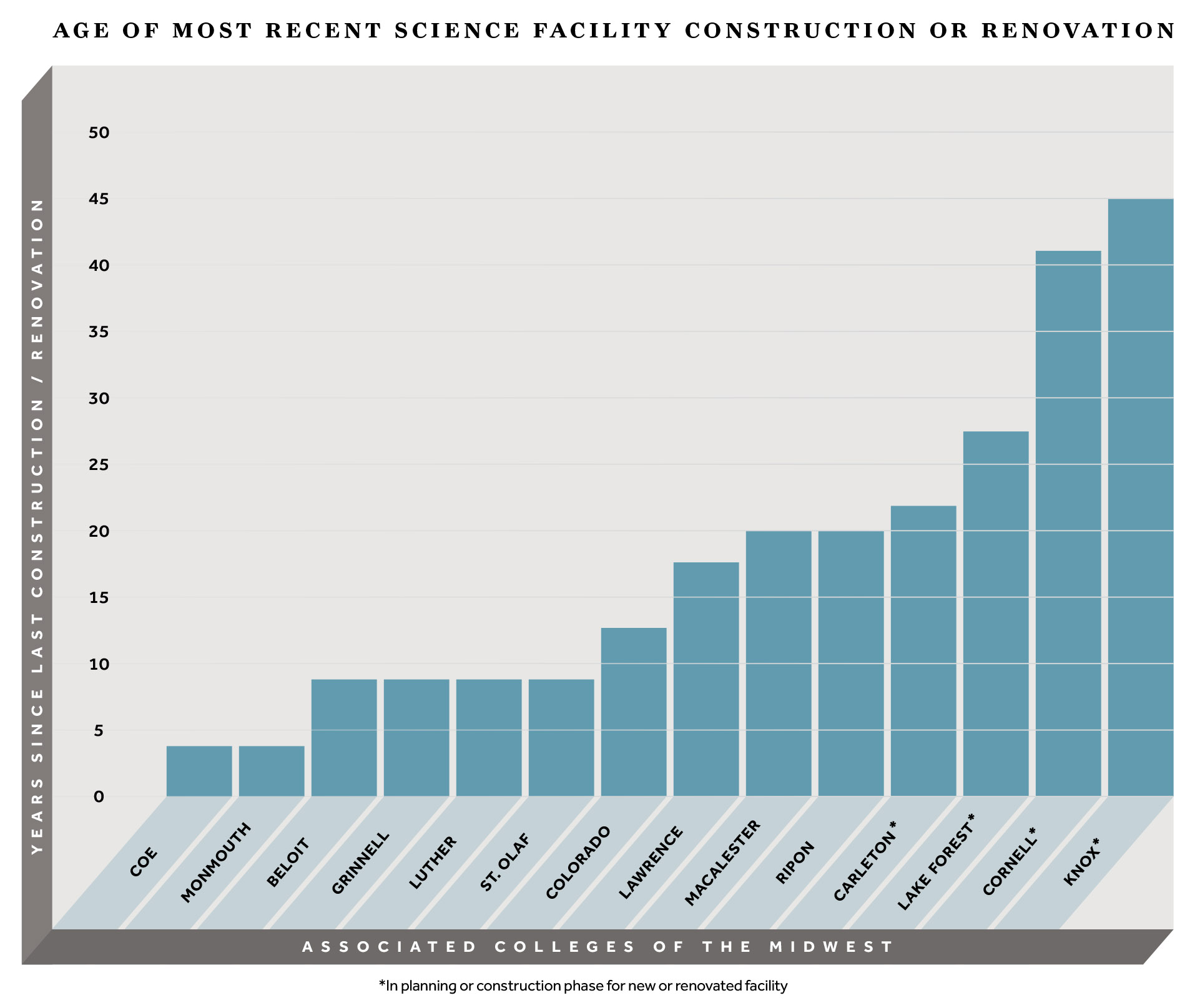
What faculty say
Planning for a science facility and renovations began four years ago as part of the college’s strategic plan. BWBR architects in St. Paul, Minnesota, were selected for the project, and they toured science facilities at other colleges with a group of Cornell faculty.
The team also made the decision about where to house each department for maximum impact. The plan: Chemistry and biology have greater infrastructure needs and will move into the new building. Computer science and mathematics and statistics will join physics and engineering in the renovated West Science, increasing collaboration among their related disciplines. Kinesiology, now the No. 2 major on campus, will gain modern facilities in Law Hall, providing opportunities for interdisciplinary collaboration with the psychological and biological sciences. The geology department is not affected, remaining in its longtime home, Norton Geology Center.
The new facility will support a much more collaborative environment, according to Ben Greenstein, Associate Dean and Professor of Geology. “At the core it’s about the student. At Cornell it’s always about the student. This project will have a galvanizing effect on a large portion of campus,” he said. “There will be a complete opening of the wall between the teaching lab and the research lab. The physical space will allow for integration. The furniture will allow seamless movement between teaching, small group, and lab learning.”
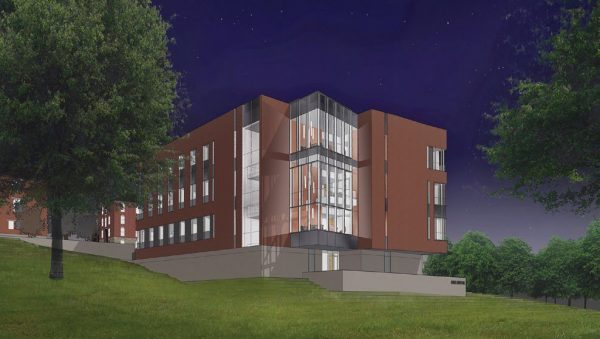
Professor of Biology Craig Tepper is excited about that new space configuration. “A rigid lab and a rigid classroom are just not the way science is taught anymore. It’s just not flexible enough,” he said. “We’re developing classroom spaces that are as flexible as possible so that the lecture and the lab and the discussion can all be integrated together, and it will be a fluid transition from one phase to the other, because there’s not a difference anymore between those.”
W.F. Johnston Professor of Physics and Engineering Kara Beauchamp was one of the faculty who toured regional science facilities, and she said it is hard to overstate the impact a new building will have on students, faculty, and visitors. “The first impression of campus comes from the buildings,” she said. “If you see really wonderful buildings, you think the campus cares a lot about whatever those buildings house. Buildings are powerful. We are creating a new building and remodeling West Science to have spaces that feel good to be in, because we want students to want to spend time in these buildings. If students stick around after class is over, we can have more meaningful interactions.”
Student study spaces are especially important to Assistant Professor of Chemistry Jai Shanata ’05. “One of the most exciting things about the project is that we’re integrating student study pods right next to our offices. This will encourage students to make really good use of their faculty. It’s a concrete way of saying we expect you to talk to us when you have questions.”
Shanata said Russell Science Center will have many more lab rooms allowing better course scheduling advantages for the block plan. Unlike a semester system in which students often enroll in two different sections of lecture and lab (taught by different people on different days), at Cornell the lecture and lab are inherently linked in a single course in many cases. With labs connected to classrooms, Shanata explained, faculty will be able to flow from lecture to lab—and back—when it is most appropriate for content. This minimizes disruption to class so students can focus on applying what they’ve learned. Spaces also will be more conducive to student-faculty research.
“We’ll have one big open lab where all research can happen, rather than the small labs we now have next to each office,” he said. “During the Cornell Summer Research Institute my research students sit in classrooms and rotate, conducting experiments in a separate small lab. Now they will be able to work in closer proximity, which will be safer and foster enhanced collaboration.”
The new facility is deliberately designed for growth. The design also allows for abundant natural light and views, and faculty offices are located front and center, as is the Dimensions Program for Health Professions office.
Meanwhile, a new dynamic will emerge in West Science.
“Math and computer science are very important components of both physics and engineering. Having them in the same building will make it far easier to collaborate, both during the school year and during the Cornell Summer Research Institute,” Beauchamp said. “Having all of our students in the same building, so that they’re talking to each other about what they’re working on, creates a lot of opportunity for over-lap and connections. Having proximity also makes it easy to have conversations about curriculum and come up with new ideas about how to work together.”
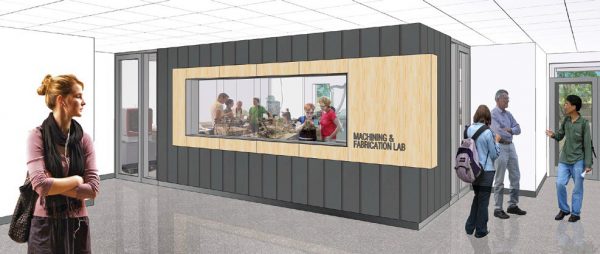
The former West Science library collection will become a highly visible engineering machining and fabrication lab near the front entrance.
What’s next
Cornell Admission staff are already emphasizing the Science Facilities Project as they promote the college to prospective students. Current students, even those who will graduate before Russell Science Center opens, are thrilled with the news.
“Science at Cornell has a very hands-on learning approach, which allows students to take their knowledge and apply it to the real world. However, the current building is hindering the faculty in providing these opportunities,” said Nina Kahn ’18, who is majoring in biology and kinesiology. “The new science building will allow faculty and students to further their learning through a more experiential environment and allow for more collaboration between peers and the professors.”
Site preparation began Nov. 30. Two homes were removed to make way for the new structure, and the architects are incorporating elements from the houses into the project. Russell Science Center will be built into the hillside next to West Science, creating an additional entrance to campus and extending the pedestrian mall to the far eastern edge.
As Cornell brings its STEM programs to the forefront with this project, the college will continue to seek the remaining $3 million needed from as many alumni and friends as possible.
“This is an ambitious school, this is a motivated school, this is an inspired school,” said President Brand. “Everything we do has to match that passion and that drive. This campaign is about solidifying further that ambition and really setting us up for the future. We want to be greater than we’ve been, we want to be greater than we ever thought we could be — we want to be great.”
With this project and this campaign, the Cornell experience will be more than great. It will be Greater > Than it has ever been.

